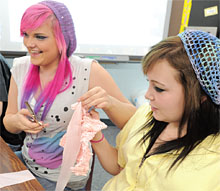
From left, students Sarah Long
and Jessica Parsons work on
the front piece for a handbag.
Move over, Coach and Louis Vuitton. Here comes a new line of hand-crafted, original, colorful and sassy handbags. These are purses with a purpose.
Funny thing is, they're made from the grocery and convenience store bags you schlep your tomatoes and toothpaste home in. With a snip here, a twist here, a tie there, and then dedicated use of a crochet hook, they're crafted into purses, reusable shopping bags and evening bags with clasps. Call it plastic on steroids.
The purses are the sweet creations of tenacious teams of students at Washington, Saratoga, Warren, Hamilton, Essex BOCES.
Their inspiration was Wangari Maathai, an environmentalist, political activist and founder of the Green Belt Movement responsible for getting 30 million trees planted in Kenya to replenish weary soil for agriculture, and to provide firewood.
They learned about her from the Speak Truth to Power social justice curriculum, which was created by NYSUT members and the Robert F. Kennedy Center for Justice and Human Rights. While studying Maathai, a Nobel Prize winner, they discovered part of her mission was recycling plastic bags.
Students used Maathai as a role model for a video they created and entered into a Speak Truth to Power contest, using student singing, narration and videography, including an interview with Saratoga Adirondack BOCES Employees Association president Bert Weber, a retired horticulture teacher, who showed students how trees impact the world.
They won first place and were scheduled to be at the Tribeca Film Festival in New York City where their winning video was to be shown.
Social studies teacher Ann Villet said she is using the RFK lessons "in order to enforce the idea of the power-of-one, and standing up for what is right." Other teachers using the lessons include Jane Amorosi, Colleen Travis and Maureen Clancy, all SABEA members.
Students started bringing in plastic bags from home, friends, neighbors, you name it. They gathered more than 1,000 of them. Teachers and teaching assistants showed them how to cut the bags and crochet them. Villet told students how these bags take 20 years to degrade on their own, and 1,000 years if they're buried in a landfill. While degrading, they release toxins into the air and soil.
Many plastic grocery bags are carelessly discarded. Who hasn't heard the rustle or snap of plastic bags as they blow around the ground, get snagged on trees or get carried by the wind into rivers?
Maathai started a project called Mottainai, a Japanese word for reduce, reuse, recycle, citing concern for "widespread" use and disposal of plastic bags in Africa. She noted animals sometimes ingest them, endangering their lives.
The Saratoga-based students decided that waste would stop on their watch. After school, and during lunch, interested students began crocheting the plastic in a craft room they named the "Recycle and Reuse Wangari Craft Room." They first followed a pattern for a French shopping bag found online by Sandie Carner-Shafran, a teaching assistant and NYSUT Board member. Colleague Niki Naushahi crocheted one for a sample. A typical purse requires about 18-20 plastic bags.
"We have prototypes of small purses, shoulder bags, market totes, coin purses and wallet or cell phone covers, along with cozies," said Carner-Shafran.
The different colors in the finished pocketbooks come from the colors in the plastic bags, usually from a store's lettering or logo. One red clasp purse they made is from a plastic tablecloth left over from a birthday party.
Occasionally, they will crochet during a teacher's lecture, which helps to calm those who have anxiety. Teaching assistant Agnes Walter is also on hand to help the students as they learn their craft.
Some students take the goods home to crochet, involving family members in recycling or crocheting. Others are learning how to make small clutch bags for the prom. One boy is turning bags into a rug.
The goal is to sell finished bags on Earth Day, and send a donation to the Green Belt movement (www.greenbeltmovement.org).
Other goods will be for sale as well, as students find more discarded materials to imprint as art rather than trash. A railing from a deck is now a candle holder; cracked teacups now embellish a wall mirror.
Meanwhile, the project itself has been an act of social justice, Villet said, noting that all levels of the school community have come together to work toward a common goal and "inspire a community."